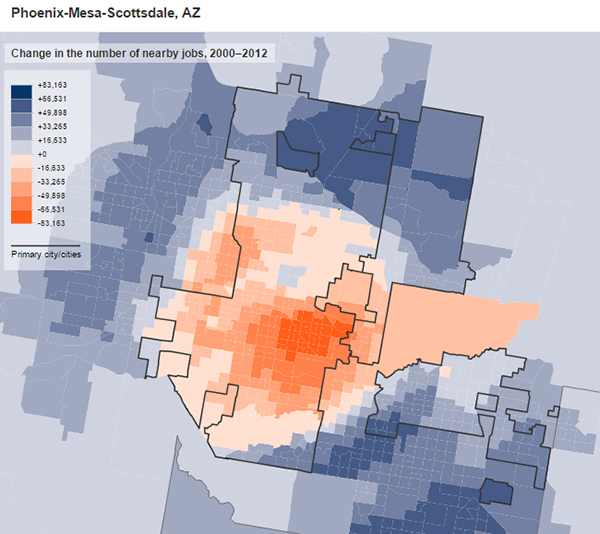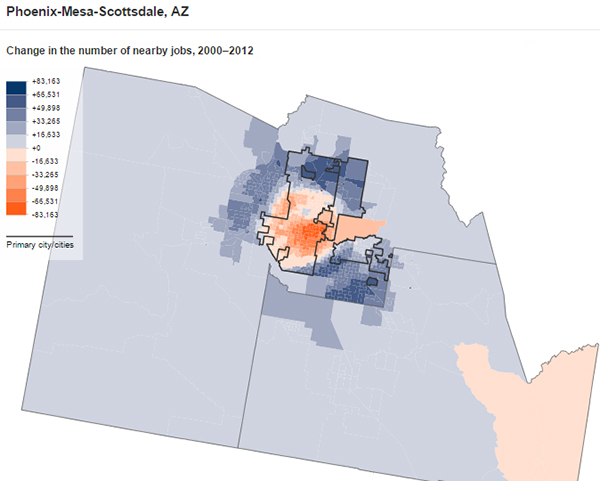Our recent report examined the growing distance between people and jobs across U.S. metropolitan areas with some troubling implications for community fiscal health and employment prospects for residents.
However some regions—29 to be exact—bucked that trend. In those 29 metro areas, the average household was near more jobs in 2012 than in 2000. Not coincidentally, all 29 posted gains in total jobs across that period, which in turn helped put more jobs within reach of more households across the region.
But just because a region’s jobs increased doesn’t mean that its households’ proximity to jobs improved. To understand why, have a look at Greater Phoenix.
Across the 2000s, the Phoenix region boomed in residents and jobs, particularly in the suburbs during the housing credit bubble. From 2000 to 2009-13, Greater Phoenix’s suburban population grew by a staggering 62 percent (compared to 9 percent in the cities of Phoenix, Mesa, and Scottsdale). Jobs in the region’s suburbs grew by 36 percent, at a time when they grew by only 2 percent on average across large metro areas.
Despite that growth, most of the region’s jobs remain in the urban core. In 2012, Phoenix, Mesa, and Scottsdale together accounted for almost two-thirds of jobs in Greater Phoenix. As the map shows, however, proximity to jobs declined in many Phoenix neighborhoods in the 2000s due to the housing crisis and ensuing recession.

Residents of the region’s suburban areas, by contrast, saw nearby jobs grow. But in general, these communities have far fewer nearby jobs than neighborhoods in central Phoenix. In 2012, the average suburban community had 254,000 jobs within an 11-mile radius (the typical commute in the region), less than half the 530,000 within reach of the typical urban community.

So even as jobs grew in the Phoenix suburbs, and more people moved there during the 2000s, the much lower numbers of nearby jobs in those communities—combined with declining jobs in the urban core—meant that by 2012 the average household in Greater Phoenix lived near 16 percent fewer jobs than in 2000. While the Phoenix metro area ranked a healthy 21st among the 96 metro areas we studied for overall job change from 2000 to 2012, it ranked near the bottom (90th) on change in nearby jobs for its average household.
Well, one might think, if people choose to move to the suburbs and drive a little further to work, what’s the problem? For one thing, it’s not only wealthy homeowners who live in the Phoenix suburbs today. Many low-income people call those suburbs home—42 percent more than at the start of the Great Recession, and nearly twice as many as in 2000. Research shows that proximity to jobs really matters for these individuals, who may have fewer transportation options or more limited job search opportunities. Low-income communities in the region’s suburbs are still closer to more jobs than higher-income suburban communities, but proximity is trending downward nonetheless.
Labor markets are regional, but this new research shows that access to jobs is local. As Greater Phoenix attempts to move its economy to a higher-value, more sustainable growth path, metro leaders shouldn’t overlook the need to make their investments in economic development, housing, and transportation work together better to put growing jobs within greater reach of local citizens.


Commentary
Jobs in Greater Phoenix are growing, but getting farther away
April 2, 2015